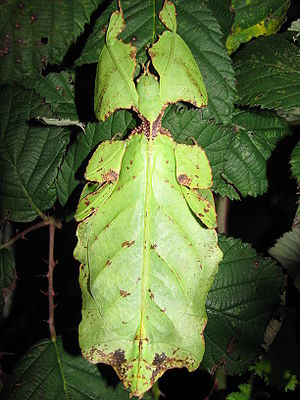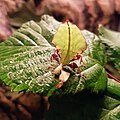Great Walking Leaf
| Great Walking Leaf | ||||||||||||
|---|---|---|---|---|---|---|---|---|---|---|---|---|

Phyllium giganteum , female |
||||||||||||
| Systematics | ||||||||||||
|
||||||||||||
| Scientific name | ||||||||||||
| Phyllium giganteum | ||||||||||||
| Hausleithner , 1984 |
The walking leaf ( Phyllium giganteum ) is the largest species of the walking leaf family (Phylliidae).
features
The male can be up to eight centimeters long and the female up to twelve centimeters long. Since captive males are very rare (for every 20 to 500 females there is one male), reproduction occurs mainly through parthenogenesis . In a comparison of breeding lines kept purely parthenogenetically with sexually reproducing specimens, "no noticeable change with regard to the sex ratio of the nymphs" can be observed. Nevertheless, male specimens are occasionally found in their habitat. The males have a relatively broad, slightly diamond-shaped abdomen . Their forewings, trained as tegmina , are short. The hind wings reach to the end of the abdomen. The females have no hind wings and their forewings are narrower and shorter than the abdomen and, unlike those of the females of Phyllium celebicum and Phyllium siccifolium , do not cover it up to the lateral body edges. A pair of eye spots can be found on the fifth abdomen segment of both sexes.
Occurrence and habitat
The animals are found in the Cameron Highlands in Malaysia , where they can be found on bushes.
Reproduction
The Great Walking Leaf reproduces parthenogenetically . After about eight months, completely red-brown nymphs hatch from the black eggs . After the first moult , they are already a little green until, as adults , they are completely green except for a few brown spots that are supposed to imitate a withered leaf. With increasing age, the adult females show more brown spots. They begin to lay eggs around four weeks after the imaginal molt. With a length of 8.5 millimeters, a width of 4 millimeters and an average weight of 34 milligrams, the eggs are the largest and heaviest of the Walking Leaves. The development time of the nymphs can take eight to twelve months. The life expectancy of an adult female is six to ten months. The males are adult after four moults and are only a few days to weeks old.
Systematics
The Great Walking Leaf was first listed by Sakaguti in 1981 under the name Phyllium pulchrifolium . In 1984 Hausleithner described the species under the name Phyllium giganteum . The holotype , a female animal, is kept in the collection of the Natural History Museum in Vienna . It is assigned to the subgenus Pulchriphyllium , making its full name Phyllium (Pulchriphyllium) giganteum .
Hennemann et al. proposed in 2009 to divide the genus Phyllium into species groups below the subgenera. Phyllium giganteum is classified here in the bioculatum species group, which, in addition to Phyllium bioculatum, is also assigned to Phyllium sinense and Phyllium pulchrifolium , which has been valid again since 2018 .
Keeping in the terrarium
In the terrarium , the temperature should be at least 22 ° C, during the day between 25 and 33 ° C and the humidity between 70 and 80 percent. The leaves of guava ( Psidium ) are preferably fed . In addition, oak leaves can be fed in summer and blackberry leaves in winter , whereby a dry edge has to be cut off, especially for smaller nymphs. The newly hatched nymphs are very sensitive and die quickly if the climatic conditions are not strictly observed. Direct spraying should be avoided.
The species is listed by the Phasmid Study Group under PSG number 72.
photos
female nymph at Exuvie
Web links
Individual evidence
- ↑ a b c d Christoph Seiler, Sven Bradler, Rainer Koch: Phasmids - care and breeding of ghosts, stick insects and walking leaves in the terrarium . Bede, Ruhmannsfelden 2000. ISBN 3-933646-89-8 .
- ↑ Alexander Esch: Poles, ghosts, walking leaves: successful keeping of phasmids. Natur und Tier - Verlag, Münster 2013, ISBN 978-3-86659-221-6 , pp. 104 .
- ↑ a b c Detlef Großer: P. giganteum on the private website Phyllium.de, accessed on September 25, 2014.
- ↑ Detlef Larger: Walking leaves . Edition Chimaira, Frankfurt am Main 2008, ISBN 978-3-930612-46-8 .
- ^ A b Paul D. Brock : Phasmida Species File Online . Version 5.0 / 5.0. (accessed November 25, 2018)
- ↑ Frank H. Hennemann ua: On certain species of the genus Phyllium Illiger, 1798, with proposals for an intra-generic systematization and the descriptions of five new species from the Philippines and Palawan (Phasmatodea: Phylliidae: Phylliinae: Phylliini) . In: Zootaxa , No. 2322, December 22, 2009, p. 63 (PDF; 5.4 MB) .
- ^ Roy Bäthe, Anke Bäthe, Mario Fuß: Phasmiden . Schüling Verlag, Münster 2009, ISBN 978-3-86523-073-7 .
- ↑ PSG Culture List on the Phasmid Study Group website .







